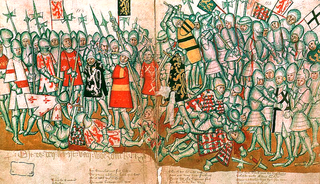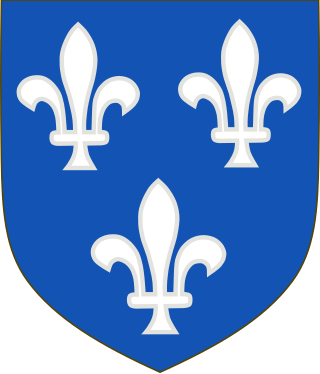
A chronicle is a historical account of events arranged in chronological order, as in a timeline. Typically, equal weight is given for historically important events and local events, the purpose being the recording of events that occurred, seen from the perspective of the chronicler. A chronicle which traces world history is a universal chronicle. This is in contrast to a narrative or history, in which an author chooses events to interpret and analyze and excludes those the author does not consider important or relevant.

John I, also called John the Victorious was Duke of Brabant (1267–1294), Lothier and Limburg (1288–1294). During the 13th century, John I was venerated as a folk hero. He has been painted as the perfect model of a brave, adventurous and chivalrous feudal prince.

Rotselaar is a municipality located in the Belgian province of Flemish-Brabant, near the convergence of the Demer and the Dijle. Since 1 January 1977 the municipality comprises the towns of Rotselaar proper, Werchter and Wezemaal. On 1 January 2006 Rotselaar had a total population of 15,068. The total area is 37.57 km² which gives a population density of 401 inhabitants per km².

The Battle of Worringen was fought on 5 June 1288 near the town of Worringen, which is now part of Chorweiler, the northernmost borough (Stadtbezirk) of Cologne. It was the decisive battle of the War of the Limburg Succession, fought for the possession of the Duchy of Limburg between on one side the Archbishop Siegfried II of Cologne and Count Henry VI of Luxembourg, and on the other side, Duke John I of Brabant.

Philip III the Good ruled as Duke of Burgundy from 1419 until his death in 1467. He was a member of a cadet line of the Valois dynasty, to which all 15th-century kings of France belonged. During his reign, the Burgundian State reached the apex of its prosperity and prestige, and became a leading centre of the arts.

Bouchout Castle is a castle in Meise, Flemish Brabant, Belgium. In the 12th century, this territory of the young Duchy of Brabant was strategically positioned between the County of Flanders and the Berthout family, lords of Grimbergen. Most likely, the first fortification was built by Wouter van Craaynem at the end of the Grimbergen Wars (1150–1170). Bouchout Castle is situated at an altitude of 32 metres (105 ft).

The United Belgian States, also known as the United States of Belgium, was a short-lived confederal republic in the Southern Netherlands established under the Brabant Revolution. It existed from January to December 1790 as part of the unsuccessful revolt against the Habsburg Emperor, Joseph II.

The (First) Battle of Vlaardingen was fought on 29 July 1018 between troops of the Holy Roman Empire and West Frisia. As a result of a trade dispute, Emperor Henry II sent an army towards West Frisia to subdue the rebellious Count Dirk III. However, the Imperial army was decisively defeated and fled in panic.

The Duchy of Brabant, a state of the Holy Roman Empire, was established in 1183. It developed from the Landgraviate of Brabant of 1085–1183, and formed the heart of the historic Low Countries. The Duchy comprised part of the Burgundian Netherlands from 1430 and of the Habsburg Netherlands from 1482, until it was partitioned after the Dutch revolt of 1566–1648.

Guillaume Wittouck was a lawyer and High Magistrate born in the Austrian Netherlands. He was the Grandfather of industrialist Paul Wittouck and of Belgian navigator Guillaume Delcourt.
Richardis of Bavaria was a German noblewoman. She was a daughter of Count Palatine Otto I of Bavaria, who later became the first Wittelsbach Duke of Bavaria, and his wife Agnes of Loon.

The Brabantsche Yeesten or Gestes de Brabant is a rhyming chronicle of some 46,000 verses written in the 14th and 15th centuries in the Middle Dutch language. It provides a history of the Duchy of Brabant, and the original five volumes were written by Jan van Boendale of Antwerp; his text was later extended to seven volumes by an anonymous continuator.

Het Noordbrabants Museum is an art museum in 's-Hertogenbosch, Netherlands.

Jan van Boendale, formerly sometimes known as Jan De Klerk was a 14th-century secretary of the city of Antwerp and author of narrative and didactic verse. Two of his works, Brabantsche yeesten and Der leken spieghel, are listed in the Canon of Dutch Literature compiled by the Digital Library for Dutch Literature.

The War of the Brabantian Succession was a war of succession triggered by the death of John III, Duke of Brabant. He had no sons, and as the Duchy of Brabant had a tradition of male (agnatic) primogeniture, his three daughters and their three husbands, namely the dukes of Luxemburg and Guelders and the count of Flanders, claimed the inheritance.
The Lords of Westerlo were the feudal lords of the fiefdom of Westerlo until the abolition of feudalism in 1795. The first known Lord of Westerlo was the Frankish nobleman Ansfried of Utrecht who gave this domain as allodial title to the chapters of Saint-Martin and Saint-Salvator in Utrecht after he became Bishop of Utrecht in 995. Since the late 15th century the Lords of Westerlo have been members of the House of Merode. In 1626 Westerlo was elevated to the rank of marquessate by King Philip IV of Spain in favor of Philippe I de Merode who became the first Marquess of Westerlo. The chief of the House of Merode still bears the title of Marquess of Westerlo although the feudal rights attached to this title have been abolished since 1795. In the nineteenth and first half of the twentieth century the 10th, 11th and 12th Marquess have been elected Burgomaster of Westerlo.

The Pipenpoy family (/pɪpɒ̃pwə/), was an old and influential patrician family of Brussels which exercised public functions in the capital of the Duchy of Brabant until the end of the Ancien Régime. It died in 1832 with Catherine de Pipenpoy, who was 100 years old. Several of its members were admitted to the Seven Noble Houses of Brussels.

Dussen Castle is a water castle that got its peculiar form after being destroyed by the St. Elizabeth's flood of 1421.

The Van Cotthem family was an old patrician family of Brussels which exercised public functions in the capital of the Duchy of Brabant. Several of its members were aldermen of Brussels, and several were admitted to the Seven Noble Houses of Brussels. The family belonged to the House of Sweerts, the second of the Seven Noble Houses of Brussels.
















